#thalattosuchia
Text
Fossil Crocs of 2023
2023 has been a year with its ups and downs, but one consistent thing has been its fossil crocs at least, giving us another interesting variety of species and genera not known before. Like last year, I'll go down each of them (including phytosaurs) and give you some key notes. And since I've done my best to make individual posts for them I'll link those when available. I'll also try to give translations where possible, but do note that sometimes I might switch around a word due to it just sounding awkward otherwise.
Scolotosuchus
Starting us off is Scolotosuchus basileus ("royal scythian crocodile"), a basal, rauisuchian-like animal from the early stages of the Triassic. An animal roughly 3 meters long, it is primarily known from vertebrae and some other material, which however does have interesting implications. Based on the anatomy of the vertebrae, it has been speculated that Scolotosuchus performed a lot of rapid movement of the neck, presumably while hunting. Furthermore, it might be that Scolotosuchus lacked osteoderms, instead having developed a bracing system for its body much more like that of dinosaurs and mammals.
Artwork by @knuppitalism-with-ue (he'll pop up quite a lot)

Colossosuchus
Fast forward to the Late Triassic, the hayday of early Pseudosuchians, and we find our first phytosaur of the list. Colossosuchus techniensis ("colossal crocodile of the Indian Institute of Technology") was an enormous animal from India's Tiki Formation. This one is known from undisputably better material, perhaps some of the best on this list as we have an entire bone bed of these guys, possibly representing a mass death site. Size estimates of the large specimens generally range from 6 to 9 meters in length, also making it the largest animal of this list, with the authors favoring an estimated 8 meters for the largest individual. Of course this is all subject to change, as we don't know the precise proportions (the downside of a bone bed is that all the bones are kinda jumbled together and god knows what belongs to what).
Artwork by Joschua Knüppe again, a female being courted by an overconfident and confused Volcanosuchus (told you so)

Kryphioparma
Ok I won't bother you with this one too much. Kryphioparma caerula ("blue mysterious shield") is an aetosaur from the Late Triassic Chinle Formation of Arizona. Now aetosaurs are cool of course, but the thing is that Kryphioparma is known from exclusively osteoderms, their large armour plates. While thats valid, its also not really exciting (as you could have guessed from the absolute lack of artwork). Best I can say is that it coexisted with a bunch of other aetosaurs, which surely would have been a sight to see back in the day.
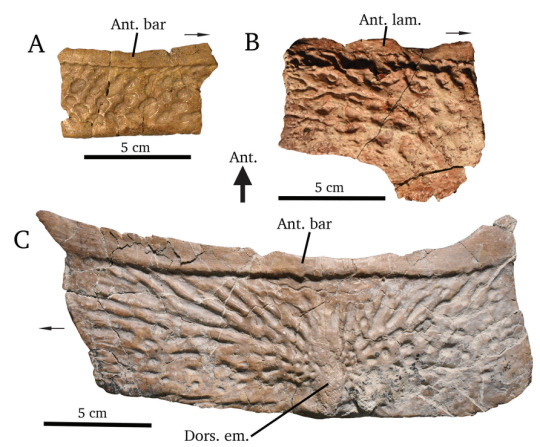
Venkatasuchus
Now Venkatasuchus armatum ("Venkata's armoured crocodile") is in a similar boat. This Indian aetosaur too is only known from osteoderms, tho at least a lot more of them that were found together, meaning we got a much better idea of its shape. There are some interesting implications it has on paleogeography and how different animal groups spread across Pangea, but that's probably beyond the scope of this post. There is at least some art of it tho, including one piece by Joschua featuring Jaklapallisaurus, an early sauropodomorph.

Mystriosuchus alleroq
Now we got our first new species of a preexisting genus. While I did my best to make posts on new genera, which typically went hand in hand with their respective wikipedia pages, species are a different matter since they'd require me to overhaul and research the whole genus. Which for Mystriosuchus would go all the way back to 1896.
Anyhow, Mystriosuchus alleroq ("jawbone spoon crocodile") is the newest in a long line of Mystriosuchus species and has been recovered from western Greenland of all places. Like Colossosuchus it is known from multiple individuals, at least four in fact, And like Venkatasuchus, it appears to have wideraning implications for the spread of archosaurs during the Triassic. Oh look its Josch's art again, neat.

Jupijkam
The final phytosaur and the final Triassic taxon of the year, Jupijkam paleofluvialis ("horned serpent of ancient rivers") was recovered from Nova Scotia Canada and represents one of the northernmost phytosaurs (alongside obviously our friend Mystriosuchus alleroq above). It is far less complete than the other phytosaurs I covered so far, but still nothing to scoff at. It's also one of the youngest known phytosaurs, possibly having lived during the last stage of the Triassic. There's no art but here's an image of its snout from the original paper.
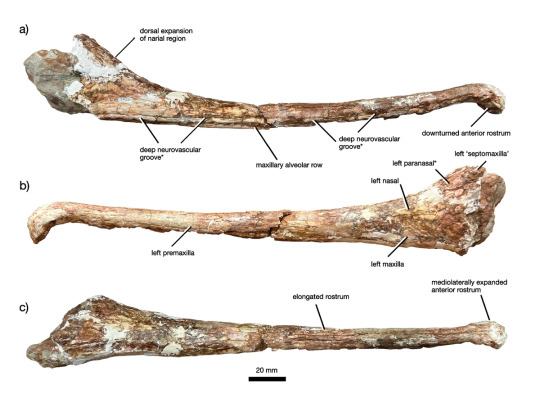
Turnersuchus
And with this we have reached the Jurassic and somewhat of a double feature. Ordering these via chronology makes this almost like storytelling. Turnersuchus hingleyae ("Hingley's and Turner's crocodile") is the oldest and basalmost named thalattosuchian, a group of crocodylomorphs that took to the seas. As such it shows a mosaic of features, already having begun to reduce its limbs, having a moderately long snout and still bearing osteoderms, which some of its descendents would come to lose. Turnersuchus dates to the Pliensbachian, a stage of the early Jurassic, tho the paper mentions how its not likely to hold its title as oldest member of its group for long as even older material has been discovered and is awaiting publication.
Artwork by Júlia d’Oliveira and Joschua Knüppe
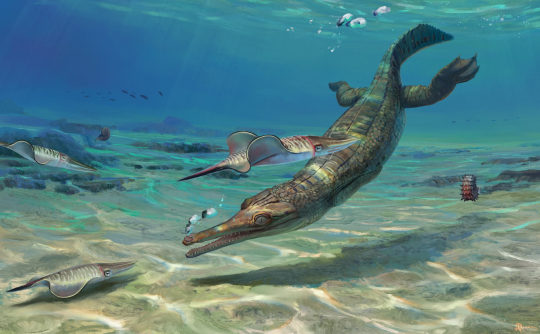
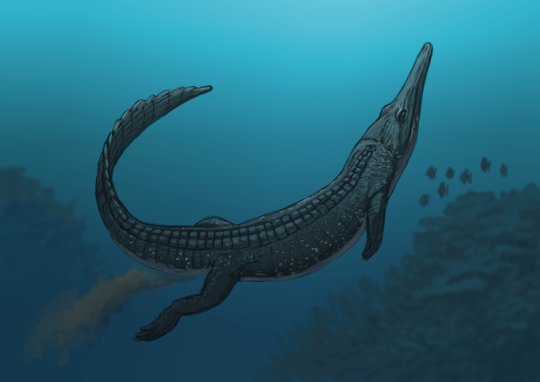
Torvoneustes jurensis
While Turnersuchus gives us a glimpse at what the earliest thalattosuchians were like, Torvoneustes jurensis ("savage swimmer of the Jura Mountains") represents them at one of their most derived. At 4 meters long, it must have been an impressive creature, entirely smooth and lacking osteoderms, highly reduced arms and a tail fluke to boot. There are some interesting features, as unlike other species of Torvoneustes, this one does not appear to have been as durophagous, instead appearing to be more of a generalist. It's the last Jurassic croc of the year and practically lived at the opposite end of this time period relative to our previous thalattosuchian, during the Kimmeridgian. Artwork by Sophie De Sousa Oliveira, not to be confused with Jùlia who drew Turnersuchus.

Comahuesuchus bonapartei
From marine to terrestrial, Comahuesuchus bonapartei is a member of the Notosuchia, land-dwelling cousins to the Neosuchia. This new species is known from the Cretaceous of Argentina and was described on the basis of a lower jaw, which differs from the previously described species of Comahuesuchus by the fact that the teeth are situated in individual sockets. Its jaws were short and wide, being described as U-shaped, giving it a somewhat pug-nosed appearance. In case you're wondering why I don't have the translation of the name thats because I can't access Bonaparte's first paper, so all I can say is that the new species is named after famed Argentinian paleontologist Jóse Fernando Bonaparte. Artwork by I mean you probably guessed it, its Josch again.
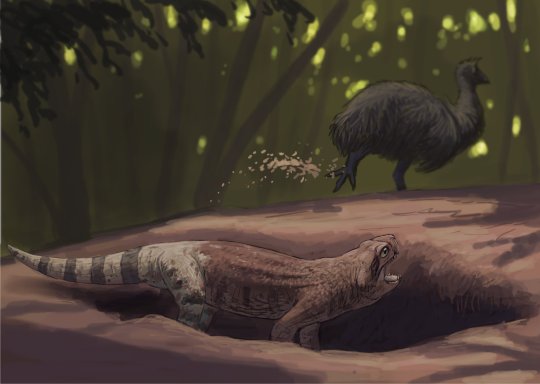
Aphaurosuchus kaiju
I have some mixed feelings on Aphaurosuchus kaiju ("powerless kaiju crocodile"), not just because I have to rewrite its genus wikipedia page that I am no longer happy with. No, Aphaurosuchus is a great genus in my opinion, given the complete nature of the holotype. But I do think that the species name of this second form is a bit of an exaggeration, seeing as it is to my knowledge not that exceptionally big. So why name it kaiju other than to sound cool? I also think it just kinda becoms funny when you consider the meaning of the genus name. Anyhow, it does look pretty mean, but thats to be expected from a baurusuchid. It lived during the Late Cretaceous in Brazil and the phylogenetic analysis that accompanied its description had some interesting implications that I'm curious to see tackled in the future. Other than that it's just another baurusuchid from a place crawling with baurusuchids, which tbh is pretty cool itself but doesn't really help make it stand out. Arwork by Paula Zeinner
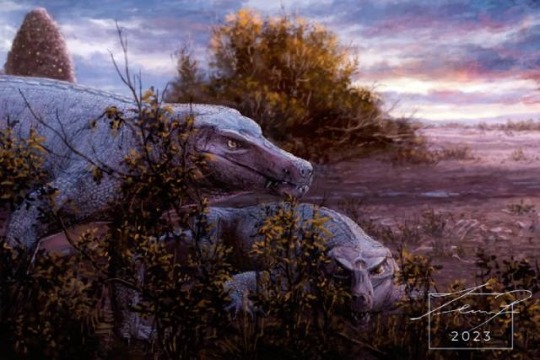
Dentaneosuchus
It is the middle Eocene. France is entirely occupied by mammals. Well, not entirely... One indomitable reptile still holds out against the invaders. Yes, I am of course talking about Dentaneosuchus ("frightfull crocodile"), the titan of the Eocene, the terror of the jungle. Easily among the most exciting finds, this animal was an enormous sebecid previously thought to be a member of the genus Iberosuchus, but recent research not only shows its distinct but enormous. With a lower jaw around 90 cm long, it rivals even the famed Barinasuchus of Miocene South America. The total body lenght is of course a matter of debate given how little we know about sebecid proportions, with the paper lowballing it at 3 to 4 meters and I personally recovering something more akin to 5 meters. Regardless of the specifics, this would make it easily one of the top predators of its time, tho sadly this was not meant to last. It was among the last non-mammalian apex predators of Europe, before climate change and competition from mammals eventually drove them to extinction.
Arwork by Joschua Knüppe and @mariolanzas
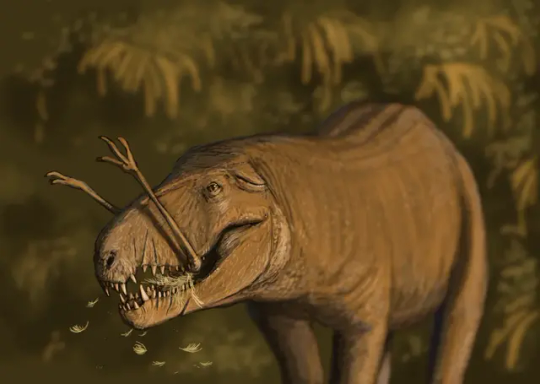
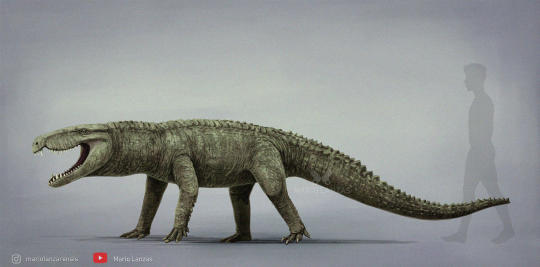
Baru iylwenpeny
Our last three entries were all members of the Notosuchia, the terrestrial crocodiles that existed from the Jurassic to the Miocene, so lets jump to the other major group of the time, the Neosuchians, specifically their most recent branch, the Crocodilians. Yes finally we are getting to crocs in the stricter sense.
Baru iylwenpeny ("divine crocodile thats good at hunting") is an animal we also knew for a while under the informal name Alcoota Baru based on where it was found. This year I spent a lot of time writing in the Mekosuchinae, Australasian crocodiles of the Cenozoic and just when I had finished the page for Baru, this guy got published. It's the largest, most robust and most recent member of the genus. Good at hunting is a good choice for the species name, as this animal was over 4 meters long with a head commonly likened to a cleaver and a hunting style speculated to consist of inflicting a lot of trauma on its prey with its massive teeth. I could gush about Baru for ages, but thats the important parts. It lived in central Australia during the Miocene only 8 million years ago.
Artwork by the incredible @manusuchus
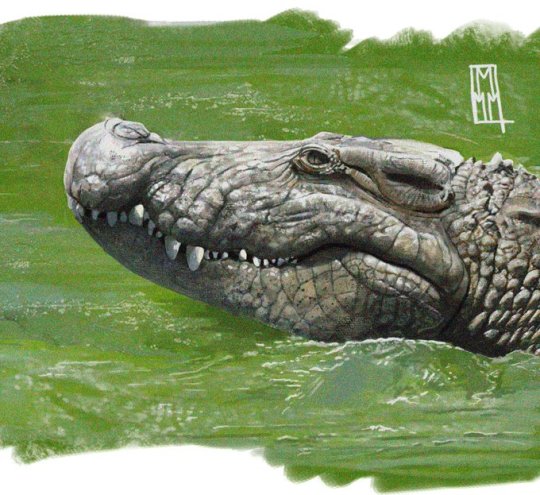
Antecrocodylus
Now for the last crocodilian described this year and one I remised to make a dedicated post for due to time constraints (I had a busy few months). Antecrocodylus chiangmuanensis ("before Crocodylus from Chiang Muan") is a close relative of the modern dwarf and true crocodiles from the Miocene of Thailand. It is only known from the back of the skull and an associated lower jaw, but it serves to highlight how little we know about the crocodiless of eastern Asia during the Miocene, which is a shame given that this region is crucial to deciphering where true crocodiles originated.

Alligator munensis
And our final taxon is Alligator munensis ("Mun river alligator"), which, obviously, is a member of the modern genus Alligator and thus most closely related to the still extant Chinese and American Alligator. Likely having been split from its Chinese relatives when the Tibetan plateau was lifted up, this species lived during the middle Pleistocene in Thailand and may have survived until the Holocene. It's head was short and robust and its teeth globular, which could indicate that it fed on hard-shelled prey like clams and snails. It was also small, likely not much bigger than 1.5 meters.
Artwork by Joschua Knüppe
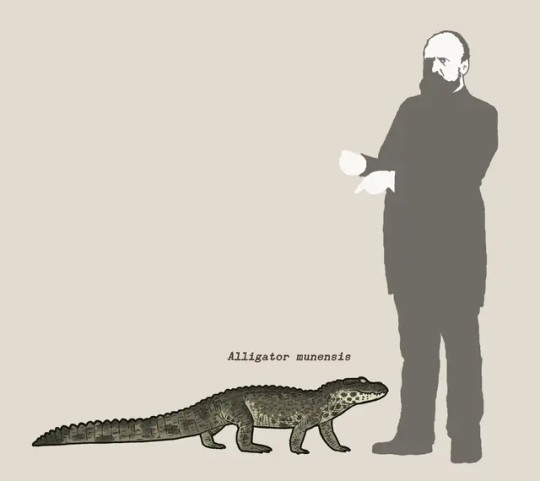

And that should be all of them, all new species and genera of Pseudosuchians described this past year. It's once again been fun to look back and I hope that you find them just as interesting as I do. Lets hope that 2024 will bring equally fascinating discoveries.
#alligator munensis#alligator#croc#crocodile#pseudosuchia#notosuchia#crocodilia#crocodylus#antecrocodylus#thalattosuchia#torvoneustes#paleontologoy#torvoneustes jurensis#turnersuchus#comahuesuchus#aphaurosuchus#aphaurosuchus kaiju#dentaneosuchus#jupijkam#colossosuchus#palaeoblr#prehistory#kryphioparma#venkatasuchus#mystriosuchus#scolotosuchus#baru#baru iylwenpeny#science
260 notes
·
View notes
Text

A worn crocodylomorph tooth of a Dakosaurus maximus from the Kimmeridge Clay in the Wicklesham Pit in Faringdon, Oxfordshire, England. This species of marine croc was likely fully aquatic and hunted plesiosaurs and ichthyosaurs. The heavy wear seen in this tooth is due to these Jurassic fossils from the Kimmeridge Clay being reworked into the overlaying Lower Cretaceous aged Faringdon Sand.
#crocodylomorpha#fossils#paleontology#palaeontology#paleo#palaeo#dakosaurus#metriorhynchidae#thalattosuchia#jurassic#mesozoic#prehistoric#science#paleoblr#ダコサウルス#メトリオリンクス科#タラットスクス亜目#海ワニ#ワニ#化石#古生物学
17 notes
·
View notes
Text
My second paper is out!
I'm second author rather than first on this one, but if you have any questions on it feel free to reach out! It's about the grooves we found on the palates of fossil crocodylomorph skulls! These palatal grooves (PG in the thumbnail image) are found in Thalattosuchians, crocodylomophs adapted for live at sea!
34 notes
·
View notes
Text

From Dinosauriërs, written by Peter Klepsch and published in the 80s. Illustrated by Thomas Thiemeyer.
(via)
#prehistoric#prehistoric reptiles#prehistoric marine life#icthyosaurs#thalattosuchia#Thomas Thiemeyer
87 notes
·
View notes
Text
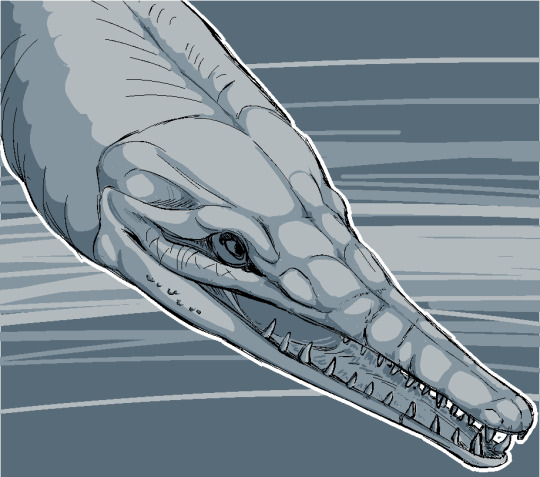
36 notes
·
View notes
Photo
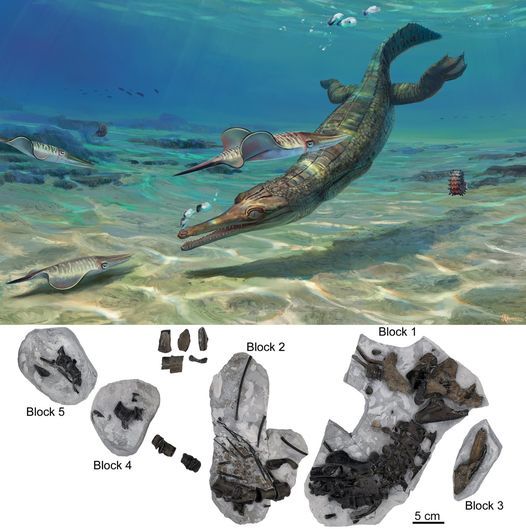
A new early diverging thalattosuchian (Crocodylomorpha) from the Early Jurassic (Pliensbachian) of Dorset, U.K. and implications for the origin and evolution of the group
Eric W. Wilberg,Pedro L. Godoy,Elizabeth F. Griffiths,Alan H. Turner &Roger B. J. Benson
ABSTRACT
Among archosaurs, thalattosuchian crocodylomorphs experienced the most extensive adaptations to the marine realm. Despite significant attention, the phylogenetic position of the group remains uncertain. Thalattosuchians are either the sister-group to Crocodyliformes, basal mesoeucrocodylians, or nest among longirostrine neosuchians.
The earliest definite thalattosuchians are Toarcian, and already possess many synapomorphies of the group. All phylogenetic hypotheses imply a ghost lineage extending at least to the Sinemurian, and a lack of older or more plesiomorphic forms may contribute to the uncertain phylogenetic placement of the group.
Here we describe a new species, Turnersuchus hingleyae, gen. et sp. nov., from the early Pliensbachian Belemnite Marl Member of the Charmouth Mudstone Formation (Dorset, U.K.). The specimen includes partially articulated cranial, mandibular, axial, and appendicular elements. It can be attributed to Thalattosuchia based on the following features: distinct fossa on the posterolateral corner of the squamosal; broad ventrolateral process of the otoccipital covering the dorsal surface of the quadrate; large supratemporal fenestrae lacking a flattened skull table; broadly exposed prootic; orbital process of quadrate lacking bony attachment with the braincase. This specimen represents the earliest thalattosuchian currently known from diagnostic material.
Phylogenetic analyses of two published datasets recover Turnersuchus as the earliest diverging thalattosuchian, and sister to Teleosauroidea + Metriorhynchoidea. Bayesian tip-dating analyses suggest a Rhaetian or Sinemurian divergence of Thalattosuchia from other crocodylomorphs, depending on topology, with confidence intervals spanning from the Norian to the Pliensbachian.
The new specimen extends the fossil record of Thalattosuchia, but the time-scaling analyses demonstrate that a significant ghost lineage remains.
Read the paper here:
https://www.tandfonline.com/doi/abs/10.1080/02724634.2022.2161909
23 notes
·
View notes
Text
Description and phylogenetic relationships of a new species of Torvoneustes (Crocodylomorpha, Thalattosuchia) from the Kimmeridgian of Switzerland
Published 19th July 2023
A new metriorhynchid from the Kimmeridgian of Porrentruyi Switzerland based on a relatively complete disarticulated skeleton, Torvoneustes jurensis.
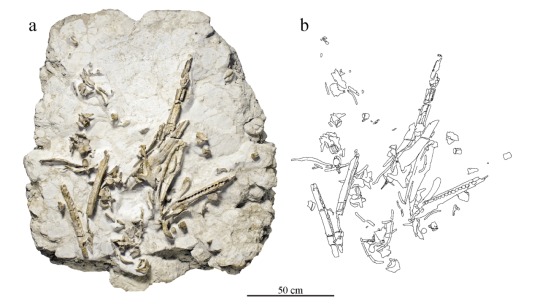
Torvoneustes jurensis holotype
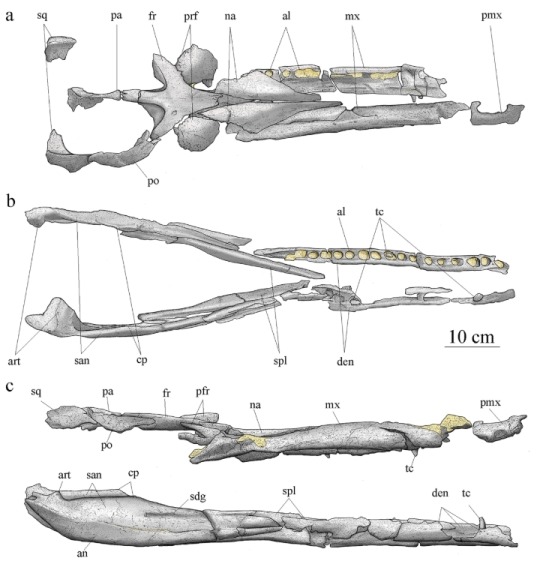
Artist illustration of jaw and mandible

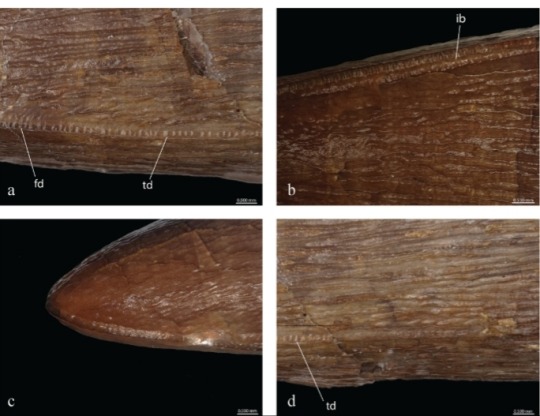
Torvoneustes jurensis teeth

Artist reconstruction of Torvoneustes jurensis, by SDSO.
Source:
9 notes
·
View notes
Photo



It's been a while since I last showed off some of these, but here's some more commission work I've done for PBS Eons:
The metriorhynchid marine crocodilians Aggiosaurus and Cricosaurus, from "When Crocs Thrived in the Seas"
https://www.youtube.com/watch?v=vgqs_9BBX10
And… what's this?

A familiar Scutellosaurus makes an appearance in a recently-published children's dinosaur book!
———
Nix Illustration | Tumblr | Twitter | Patreon
#science illustration#paleontology#paleoart#palaeoblr#pbs eons#aggiosaurus#cricosaurus#metriorhynchidae#thalattosuchia#crocodylomorpha#crocodilian#pseudosuchia#stem-croc#art#scutellosaurus#published artwork
330 notes
·
View notes
Photo


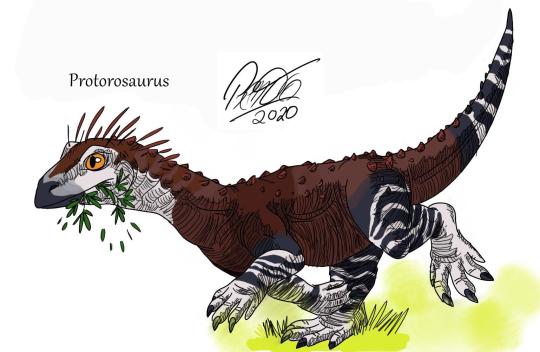
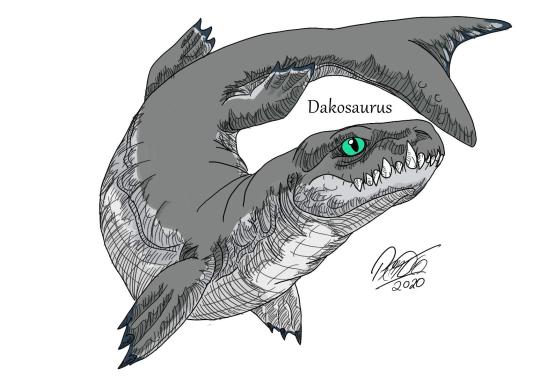


Entries 13-18 for Emily Stepp’s Archosaur Art April
Can we talk about how marine-adapted crocodiles are one of the best things evolution brought upon the face of the Earth? Just sayin’.
Oh and Stangerochampsa is munching on a Albertonykus. I really liked that “action packed” portrait with animals doing you know... animal stuff.
#artists on tumblr#digital artists#artistsoninstagram#archosauria#archosauromorph#pterosaur#crocodylomorpha#crocodile#stem caiman#caiman#alligator#thalattosuchia#marine reptile#mesozoic#cretaceous#marine reptiles#jurassic#triassic#permian#paleoart#paleontology#paleobiology#paleoillustration#creature design#palaeoart#palaeontology#autodesksketchbook#sketchbookpro#nyctosaurus#stangerochampsa
17 notes
·
View notes
Photo

The first ever restoration of this genus so far as I know. Zoneait is the oldest known metriorhynchoid, though not the most basal, as it is more derived than Eoneustes and Teleidosaurus. Described in 2015, Zoneait showed palaeontologists how metriorhynchoids evolved; as the humerus was more than twice as long as the ulna, it showed how these would eventually be shortened into fins. Zoneait also shows other basal features, as the digits have not fused together into fins as yet, but shows more derived features as well; eyes aligned on the side of the head rather than towards the top, and the presence of salt glands.
References:
-en.wikipedia.org
-"A new metriorhynchoid (Crocodylomorpha, Thalattosuchia) from the Middle Jurassic of Oregon and the evolutionary timing of marine adaptations in thalattosuchian crocodylomorphs", Eric Wilberg. (http://www.mediafire.com/file/dyb44g6ypzbbtd8/A_new_metriorhynchoid_%28Crocodylomorpha%2C_Thalattosuchia%29_from_the_Middle_Jurassic_of_Oregon.pdf)
-Skeletal mounts of Metriorhynchus and other forms for reference towards the back half
#zoneait#metriorhynchoidea#metriorhynchus#metriorhynchidae#thalattosuchia#crocodiles#crurotarsi#archosaurs#archosauromorpha#paleoart#paleo#paleoblr#palaeoblr#jurassic#aalenian#oregon#usa#midjurassic#middle jurassic#bajocian
14 notes
·
View notes
Text
Thalattosuchus and Leedsichthys
Quickly stopping by to report on a new paper describing stomach contents of a thalattosuchian (Jurassic marine crocodile).
The paper in brief describes a specimen of Metriorhynchus superciliosus (aka Thalattosuchus) with preserved stomach contents, which is already rare enough as is. What's even more interesting is that the stomach contents preserve both the gill rakes of the large fish Leedsichthys as well as various mollusc shells. Strange prey for what's a rather small piscivore. Although it was previously suggested that Metriorhynchus/Thalattosuchus attacked living Leedsichthys, this appears to have been based on missinterpreted evidence and given the enormous size difference its way more likely that the fish was simply scavenged, sorta like a kind of Jurassic whalefall. This actually finds support in the mollusc shells, which might have been ingested on accident alongside the fish remains.
Top left: The skeleton of this Thalattosuchus specimen
Top right: The stomach contents in detail (G are gill rakes, S are shells)
Bottom left: Live reconstriction of Thalattosuchus by Gabriel Ugueto
Bottom right: Live reconstruction of Leedsichthys by @knuppitalism-with-ue
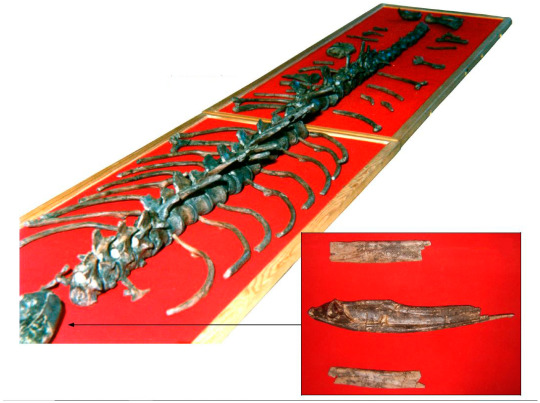
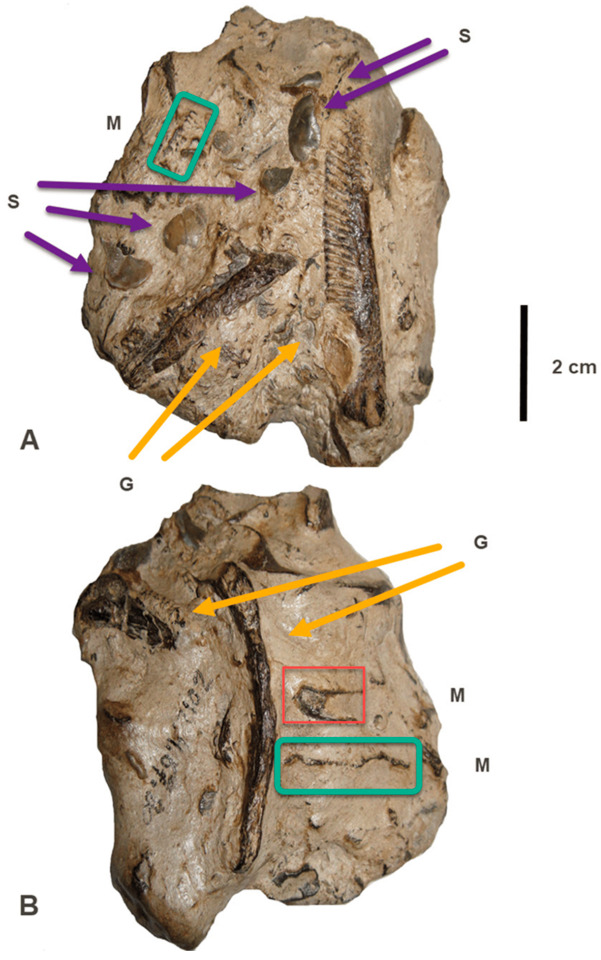
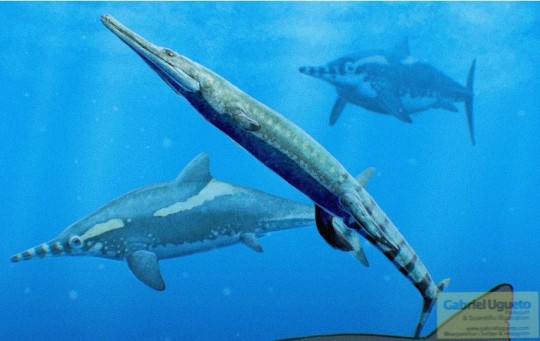

The paper itself:
Fossil Studies | Free Full-Text | The Diet of Metriorhynchus (Thalattosuchia, Metriorhynchidae): Additional Discoveries and Paleoecological Implications (mdpi.com)
#thalattosuchus#thalattosuchia#metriorhynchus#metriorhynchidae#leedsichthys#palaeoblr#paleontology#prehistory#jurassic
37 notes
·
View notes
Note
Where in Pseudosuchia are your dragons placed?
Already answered
although as I said back then, it’s likely to change. Learning a lot more about past crocodiles now I am back in university (mostly about Thalattosuchia - my dragons are not at all close to thalattosuchians but I will steal some of their biology for my sea dragons!) and a lot more about phylogeny. These things are still vague tho, I won’t pretend I have a definite answer because I really don’t.
2 notes
·
View notes
Text
Ancient Jurassic crocodiles mimicked whales and dolphins to dominate the seas
A life reconstruction of the Jurassic Period marine crocodile relative Cricosaurus (Reuters)
Deadly prehistoric crocodiles mimicked the shape and senses of whales and dolphins to dominate Jurassic seas, new research has found.
The extinct crocodiles, thalattosuchia, evolved from their land-living ancestors to become fast swimming predators.
They adapted their limbs into flippers, streamlined…
View On WordPress
0 notes